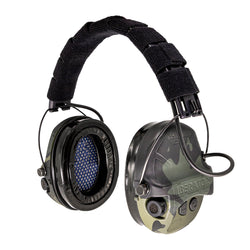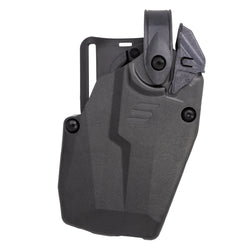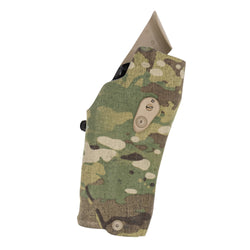The Smith & Wesson Model 10 is my favorite handgun. With that baggage packed up, it was something of an understatement that I was curious when Smith & Wesson relaunched the M10 over SHOT Show 2025.
Last I checked, it wasn’t 1899 or even 1979. Since the late 1990s, Smith & Wesson winnowed down their selection of medium-frame revolvers in favor of larger and smaller models. That much made sense, since the days of cops carrying revolvers were coming to a close. But over the last 10 years, the old K frame has made a comeback, particularly with the reintroduction of the Model 19 and Model 66 .357 Magnum models.
The revolver that started it all, the Model 10, remained in limited production as part of Smith & Wesson’s Classic Series. Now, the old M&P, yes that old M&P, is getting its due. Needless to say, I had to pull the trigger on one. Here is how it shot:
The Smith & Wesson Model 10: A Quick History
Smith & Wesson answered the US government’s request for more handguns in the lead-up to the Spanish-American War. The handgun arrived too late, but it proved to be superior and more powerful than what the Army was already fielding.
This new medium-framed revolver from Smith & Wesson was called the Military & Police and it chambered the new .38 S&W Special cartridge. During World War II, close to a million were produced for the Commonwealth, as well as the US Armed Forces, who continued to use them into the 1980s.
The M&P underwent a number of engineering changes over the years and as well as a model change when Smith & Wesson went to numeric designations in 1957. The Military & Police became the Model 10.

In 1963, a heavy-barreled version with a ramped front sight was introduced. This version of the Model 10 became the favorite amongst law enforcement and police pistol competition shooters. It is also the model that continued after all other variants left production.
Beginning in 1997, the Model 10 was produced with MIM internal action parts instead of forged parts. In 2001, a keylock safety above the cylinder release was added. The how and why behind these changes is best discussed elsewhere, but the reality is unpopular with just about any Smith & Wesson revolver enthusiast. The keylock is a particular sore point because it is a potential failure point, and its location is in the least discreet place possible. Aside from some of their small J-frame snub-nose revolvers, the key lock was a feature—until now.
Old and new: The Model 10 no lock

The new Smith & Wesson Model 10 harkens back to a mix of classic features that show up on different versions of the M&P and Model 10 line throughout the years.
The popular 4-inch pencil barrel has made a comeback, as has the distinctive pre-Model 10 half-moon front sight. The rear sight is a square cut notch in the cylinder frame. The cylinder release and flared ejector rod harkens back to the Model 1905 Hand Ejector. The plain oiled walnut service stocks are just like those on the Victory Model, the World War II military version of the M&P.

Like the old models, the new Model 10 is an all-steel revolver and comes in factory blue, like all the models in the Classic lineup. It features a case-hardened exposed hammer and trigger.
The ancestor of the Model 10 was Smith’s first mid-sized swing-out cylinder revolver, and the new Model 10 is no exception. The cylinder holds six rounds of .38 Special. There is some hesitation among shooters about using +P ammunition in older pencil barrel Model 10s. But those were fine then, and the new Model 10 is fine now. It is rated and marked for .38 Special +P ammunition.

As the preeminent Smith & Wesson K-frame, the new Model 10 will fit any K-frame leather, including the Bianchi Cyclone and Shadow holsters. Six-shot K-frame speed-loaders like the Safariland Comp. II work here just as they would for a Model 13 or Model 19. The only accessories not compatible are old-stock Model 10 parts, as this features the modern lock work, including a frame-mounted firing pin.
On the Firing Line with the Smith & Wesson Model 10
Occasionally, someone asks me to recommend a first revolver. After giving them the line about the advantages and disadvantages of the platform, I land on any flavor of Smith & Wesson K-frame, namely because they are boring to shoot.
I like my Hondas because they are boring to drive, as in they start every time I turn them on, and drive when I put them in gear.
The K-frame is boring. They tend to work with good ammo and regular maintenance. The actions are better than any snub-nosed revolver, and their size makes them easy to wield, particularly with .38 Special ammo.
The Model 10 is the most boring of all K-frames. You can’t get a kick loading .357 Magnum ammo for your friends. It is .38 Special only. It is blued. Its fixed sights don’t lose zero in fun and interesting ways.
I expected a boring experience with the new Model 10, but I also wondered if the change in lock work would materially affect how it shot, let alone how it looks.
I was also curious to see what new K-frames still had to offer. While it is impossible to reclaim the past or form an accurate picture of it with survivorship bias among those of us who still hold onto the old models, the new version gives up little in terms of actual shooting.

Loading the Model 10 is the same as any other modern Smith & Wesson revolver. Press forward on the cylinder release and roll the cylinder out to the left side of the frame. After dropping in your ammunition, close the cylinder, and you are ready to shoot.
As it is a conventional double action revolver with an exposed hammer, you can thumb cock the hammer for a light, short single action pull. Or you can level the sights on target and press the trigger in double action mode. Unloading is similar to loading, except that a press of the ejector rod is necessary to clear any empty cases.
I accounted for 300 rounds of ammunition out of the Model 10 across four different types of ammunition that came courtesy of Ammunition to Go. These included Magtech 158 grain FMJ target rounds. as well as +P defensive ammunition, including the famed Federal 158 grain lead hollow-point FBI load, Federal Hydroshock 129 grain JHPs, and Hornady 110 grain FTX loads.
This Model 10 has an equally smooth action to a vintage model, but the trigger pull weight is slightly heavier to what I usually see. In single action, the trigger breaks at 4 lbs. 4 ounces, while the double action is long and breaks at 9.5 lbs.
All the shooting I did was in double-action mode. Even so, it was not hard to get six rounds into a two-inch pattern at 10 yards with the Magtech 158 grain standard pressure load. Recoil and noise were sedate. This load also shot about three inches higher than the point of aim. As the gun wears fixed sights, the only remedy is to switch grain weights to find a load that hits to the aiming point.
The lighter +P loads did hit to the point of aim, but accuracy suffered a bit, and my groups dropped to four inches. The +P rounds were louder and caused some muzzle flip, enough to minutely break my grip on the slick-sided walnut stocks. The grips are functional and pleasing to look at, but as a shooter, checkered stocks are better.
The overall best ammunition I used was the FBI load. Over my chronograph, it runs at an average five-shot velocity of 976 feet per second and is the stoutest load out of the Model 10. But shooting it causes no discomfort out of this all-steel gun, and at ranges from 25-50 yards, the overall accuracy held up better than the rest.
At 25 yards, I could keep all six rounds into the same 4-inch pattern. Further out, the front sight starts materially covering up more of my target, and the best I could do was a seven-inch group. Even the initial issue of shooting high at 7-10 yards solved itself at those distances as the bullet arches and drops.

Unloading and reloading the Model 10 is a cinch. Even the +P loads are easy to kick out by pressing the ejector rod with the thumb. A sharp slap sends the cases out with more authority, and the flared ejector rod tip doesn’t dig into the hand while in the middle of a speed reload.
In terms of reloading options, I mixed it between reloading from the factory boxes and dusting off my K-frame loaders for some loading drills. Bianchi Speed Strips worked well for partial reload drills, but my standby Safariland Comp IIs got me reloaded as fast as can be. I fumbled a bit initially, going from firing my last round to a reloaded handgun in six seconds. Toward the end of my time with the M10, I had gotten my time down to my usual four-second reload.
As this is a mid-sized gun, it is more forgiving to bobbles when loading and unloading. There is more to hang onto and conversely, less to get in the way. The revolver’s grips are small enough to drive in a loader without it hanging on the grip. Going for speed is not necessarily relaxing, but it can get fun, and it helped me get through my round count much quicker.
The Lockless Model 10: The Start of Something Old and New
In the end, I’ve had 300 rounds downrange with the new No-Lock Model 10. I cannot say that the inclusion or exclusion of the lock made the action any better or worse, but it surely brings the tried-and-true aesthetics of the K-frame back to form.
In my time on the range, the action smoothed up some, and I got through all the ammunition with only a single malfunction—me short-stroking the trigger in my first six rounds at the range.
Although the new Model 10 is not all forged like its predecessors, it was immaterial to getting lead on target. There are plenty of Model 10s and M&Ps out there, but if you are tempted to buy new, the new No Lock Model 10 does have something to offer.









